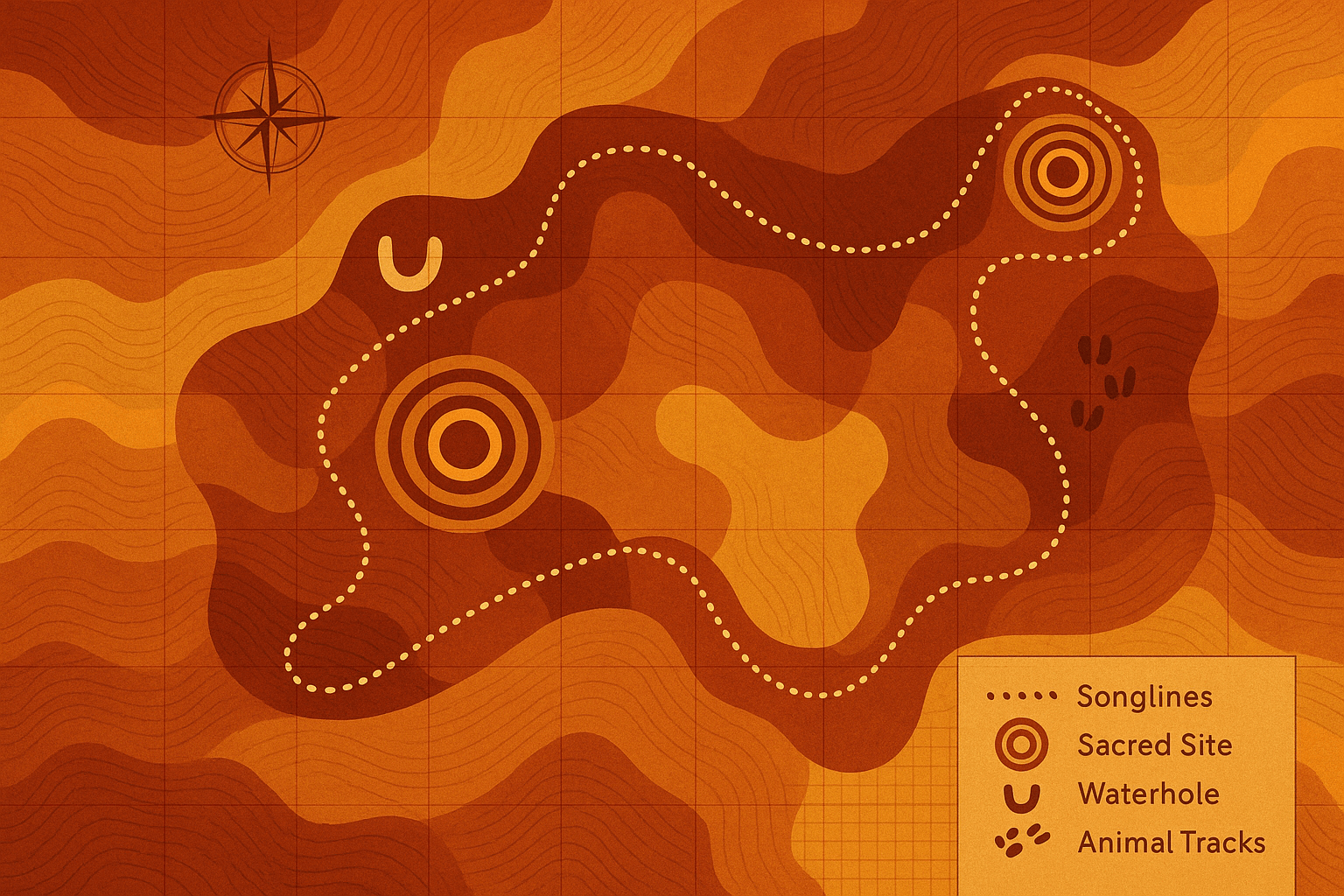For more than 60,000 years, the First Peoples of Australia have navigated, understood, and lived in harmony with their environment through an intricate oral tradition. The Songlines, sometimes called Dreaming Tracks, are pathways of knowledge that crisscross the entire continent. They are far more than just routes from A to B; they are a grand, unified theory of everything, weaving together creation, navigation, law, and genealogy into a living memory map inscribed upon the land itself.
The Dreaming and the Creation of the Map
To understand Songlines, one must first understand the foundational concept of Aboriginal spirituality: The Dreaming. The Dreaming is a complex term that refers to the genesis of the world, a time when colossal ancestral and creator beings—often in the form of humans, animals, or elements—traversed a formless land.
As these beings journeyed, they brought the world into existence. They fought battles, hunted, danced, and sang, and their every action shaped the physical world. A mountain range might be the body of a sleeping giant, a river the track left by a rainbow serpent, and a cluster of boulders the eggs of a celestial emu. The paths these ancestors walked became the Songlines.
The songs themselves are the narrative of these creation journeys. Each verse, each note, corresponds to a specific location and the events that unfolded there. To sing the song is to retrace the ancestor’s steps, to see the world through their eyes, and to bring the power of The Dreaming into the present. The landscape is not merely a backdrop for the story; it is the story.
A Navigational and Social Network
At its most practical level, a Songline is an astonishingly accurate navigational tool. The lyrics act as a set of verbal directions, with landmarks—a uniquely shaped rock, a bend in a creek, a grove of trees—serving as mnemonics. The rhythm and melody of the song can even indicate the distance to be travelled or the nature of the terrain ahead. By singing the correct sequence of songs, a person could navigate with precision across hundreds, even thousands, of kilometres of often-unforgiving country.
But no single person holds the entire map. Songlines are shared cultural property. A particular Aboriginal group is the custodian for the part of the Songline that passes through their traditional land, their ‘country’. They are responsible for its preservation, its stories, and its ceremonies.
To travel along a Songline, a traveller would need to be granted passage through neighbouring territories. As they reached the edge of their own country, they would be met by the custodians of the next section, who would then teach them the subsequent part of the song, allowing them to continue their journey. This system fostered a continent-wide network of diplomacy, trade, and social obligation, binding disparate groups together through shared ancestral heritage.
Example: The Seven Sisters Songline
One of the most extensive Songlines is that of the Seven Sisters. This epic story follows a group of seven sisters (representing the Pleiades star cluster) as they flee across the land, pursued by a powerful and relentless sorcerer named Nyiru or Wati Nyiru (representing the Orion constellation). Their chase is not just a terrestrial drama but a celestial one, mapped across both the earth and the night sky. This single Songline stretches for over 3,000 kilometres, crossing multiple desert regions and connecting many different Aboriginal language groups, from the west coast deep into Central Australia.
An Encyclopaedia of Law and Life
The Songlines are a testament to the fact that for First Peoples, culture is not separate from law, science, or history. It is all one and the same, embedded in the stories of the land. They function as a comprehensive library of knowledge, containing vital information about:
- Natural Resources: The songs encode a deep ecological understanding, indicating where to find waterholes, which plants are edible or medicinal at different times of the year, and the location of animal habitats.
- Genealogy and Kinship: Songlines connect people to their ancestors, their land, and each other. They define family relationships and social responsibilities. The question “Who’s your country?” is fundamental to identity.
- Law and Ethics: Known as ‘Lore’, the Songlines establish the rules for social conduct, resource management, and spiritual obligations. They are the ultimate legal precedent, outlining rights, responsibilities, and the consequences for transgression.
A Living History Under Threat
As one of the world’s oldest continuous historical records, the Songlines have faced unprecedented threats since European colonisation. The dispossession of people from their traditional lands severed the physical connection to the stories. When a sacred site is destroyed by mining or urban development, it is akin to ripping a page from a history book or erasing a line from the map forever.
Furthermore, policies that suppressed Indigenous languages and cultural practices directly attacked the oral transmission that is the lifeblood of the Songlines. With each Elder who passes away without being able to transmit their knowledge, a part of this ancient library risks being lost.
Despite these immense challenges, the Songlines endure. Today, Aboriginal communities are working tirelessly to revive, document, and teach their ancestral heritage. Innovative projects use modern technology like digital mapping, virtual reality, and audio archives to engage younger generations and preserve the songs for the future. These efforts are not about fossilising the past but about affirming the Songlines’ place as a living, breathing system of knowledge that continues to guide, sustain, and define the First Peoples of Australia.
The Songlines are a profound reminder that a map can be more than lines on paper. It can be a song, a story, and a spiritual guide. It is a powerful testament to the ingenuity and resilience of a culture that has mapped its memory onto a continent.
